radiator cap DODGE MAGNUM SRT 2007 1.G Owners Manual
[x] Cancel search | Manufacturer: DODGE, Model Year: 2007, Model line: MAGNUM SRT, Model: DODGE MAGNUM SRT 2007 1.GPages: 380, PDF Size: 6.63 MB
Page 278 of 380
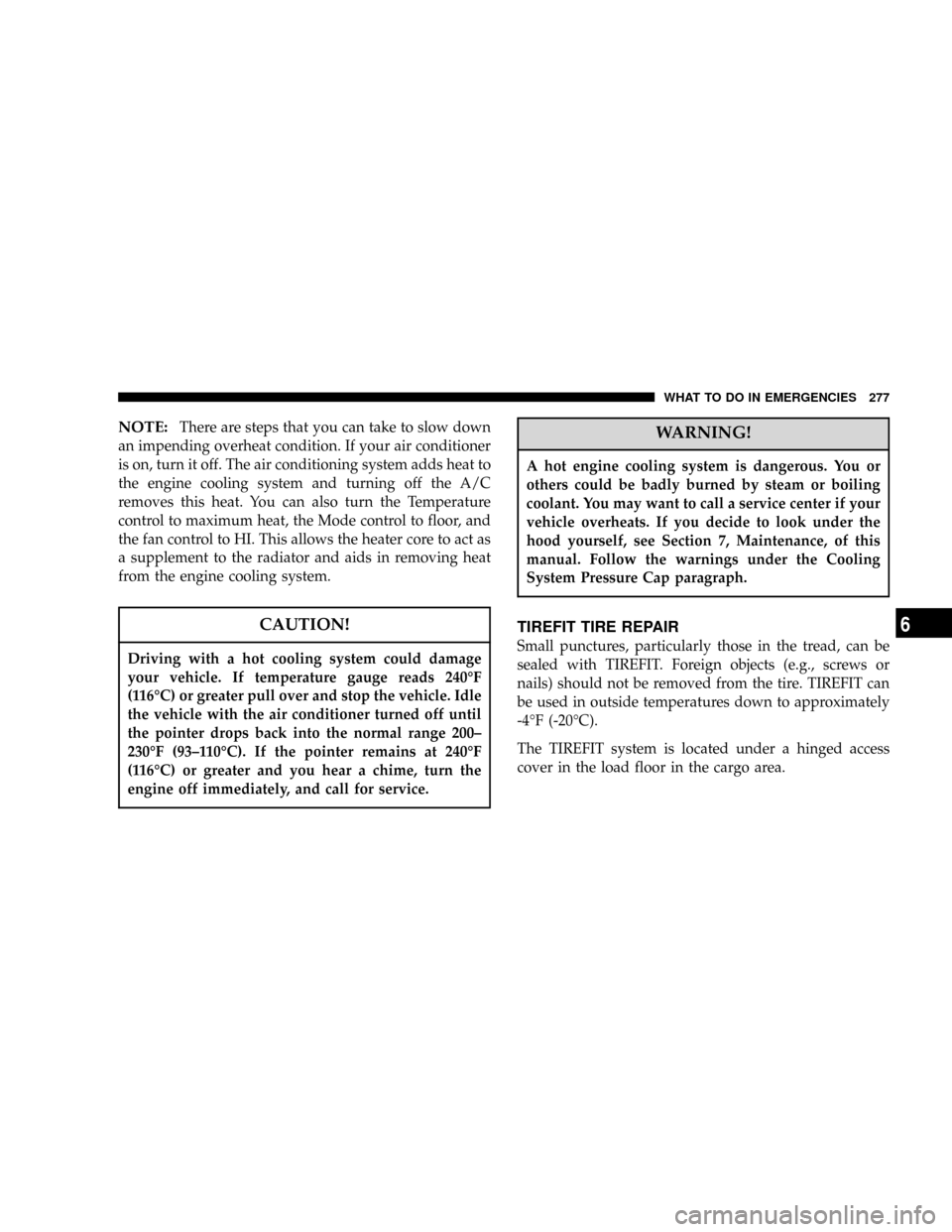
NOTE:There are steps that you can take to slow down
an impending overheat condition. If your air conditioner
is on, turn it off. The air conditioning system adds heat to
the engine cooling system and turning off the A/C
removes this heat. You can also turn the Temperature
control to maximum heat, the Mode control to floor, and
the fan control to HI. This allows the heater core to act as
a supplement to the radiator and aids in removing heat
from the engine cooling system.
CAUTION!
Driving with a hot cooling system could damage
your vehicle. If temperature gauge reads 240ÉF
(116ÉC) or greater pull over and stop the vehicle. Idle
the vehicle with the air conditioner turned off until
the pointer drops back into the normal range 200±
230ÉF (93±110ÉC). If the pointer remains at 240ÉF
(116ÉC) or greater and you hear a chime, turn the
engine off immediately, and call for service.
WARNING!
A hot engine cooling system is dangerous. You or
others could be badly burned by steam or boiling
coolant. You may want to call a service center if your
vehicle overheats. If you decide to look under the
hood yourself, see Section 7, Maintenance, of this
manual. Follow the warnings under the Cooling
System Pressure Cap paragraph.
TIREFIT TIRE REPAIR
Small punctures, particularly those in the tread, can be
sealed with TIREFIT. Foreign objects (e.g., screws or
nails) should not be removed from the tire. TIREFIT can
be used in outside temperatures down to approximately
-4ÉF (-20ÉC).
The TIREFIT system is located under a hinged access
cover in the load floor in the cargo area.
WHAT TO DO IN EMERGENCIES 277
6
Page 308 of 380

Cooling System
WARNING!
²When working near the radiator cooling fan, dis-
connect the fan motor lead or turn the ignition
switch to the OFF position. The fan is temperature
controlled and can start at any time the ignition
switch is in the ON position.
²You or others can be badly burned by hot coolant
or steam from your radiator. If you see or hear
steam coming from under the hood, don't open
the hood until the radiator has had time to cool.
Never try to open a cooling system pressure cap
when the radiator is hot.
Coolant Checks
Check engine coolant (antifreeze) protection every 12
months (before the onset of freezing weather, where
applicable). If coolant is dirty or rusty in appearance, the
system should be drained, flushed and refilled with fresh
coolant. Check the front of the A/C condenser for any
accumulation of bugs, leaves, etc. If dirty, clean by gently
spraying water from a garden hose vertically down the
face of the condenser.
Check the coolant recovery bottle tubing for brittle rub-
ber, cracking, tears, cuts, and tightness of the connection
at the bottle and radiator. Inspect the entire system for
leaks.
With the engine at normal operating temperature (but
not running), check the cooling system pressure cap for
proper vacuum sealing by draining a small amount of
coolant from the radiator drain cock. If the cap is sealing
properly, the engine coolant (antifreeze) will begin to
drain from the coolant recovery bottle. DO NOT RE-
MOVE THE COOLANT PRESSURE CAP WHEN THE
COOLING SYSTEM IS HOT.
MAINTAINING YOUR VEHICLE 307
7
Page 310 of 380
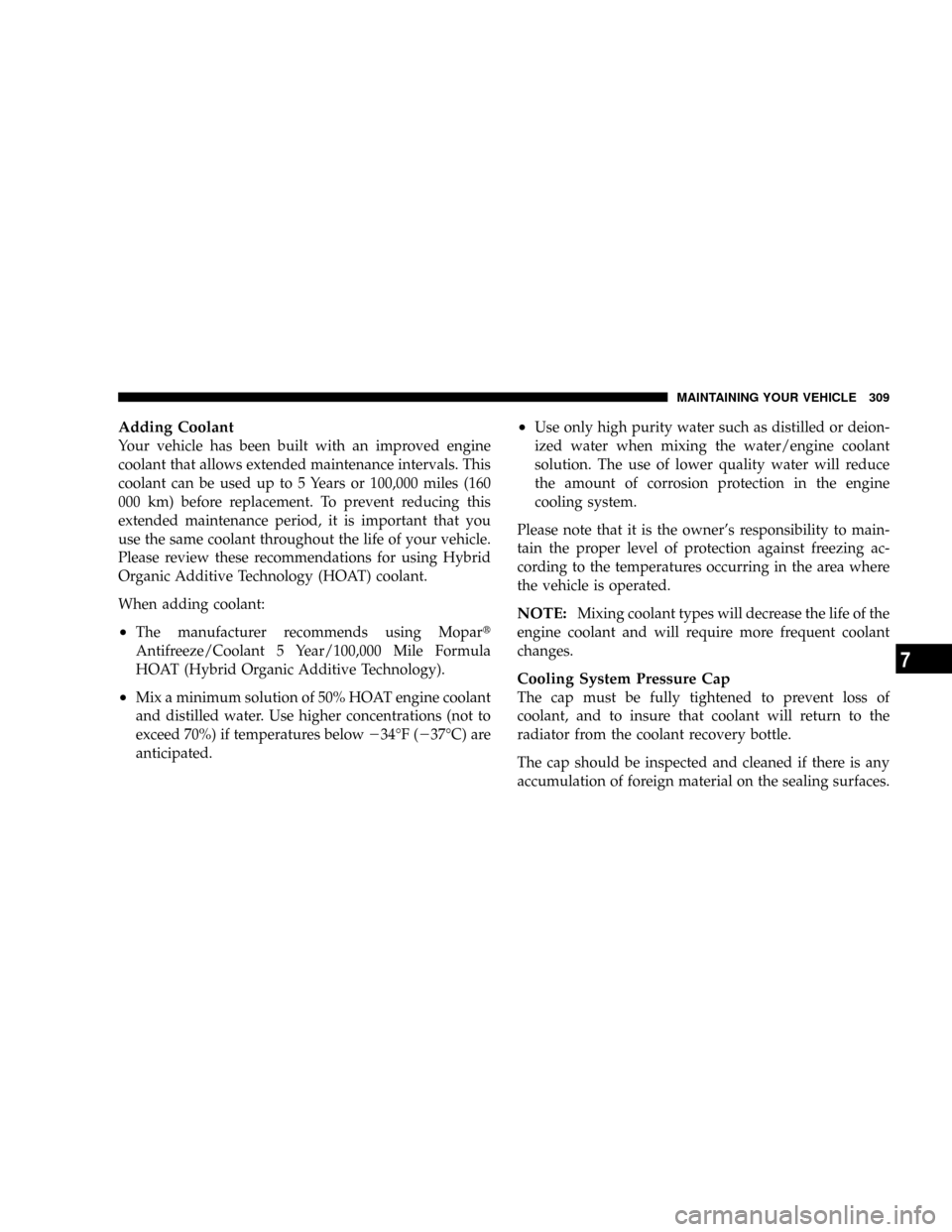
Adding Coolant
Your vehicle has been built with an improved engine
coolant that allows extended maintenance intervals. This
coolant can be used up to 5 Years or 100,000 miles (160
000 km) before replacement. To prevent reducing this
extended maintenance period, it is important that you
use the same coolant throughout the life of your vehicle.
Please review these recommendations for using Hybrid
Organic Additive Technology (HOAT) coolant.
When adding coolant:
²The manufacturer recommends using Mopart
Antifreeze/Coolant 5 Year/100,000 Mile Formula
HOAT (Hybrid Organic Additive Technology).
²Mix a minimum solution of 50% HOAT engine coolant
and distilled water. Use higher concentrations (not to
exceed 70%) if temperatures below234ÉF (237ÉC) are
anticipated.
²Use only high purity water such as distilled or deion-
ized water when mixing the water/engine coolant
solution. The use of lower quality water will reduce
the amount of corrosion protection in the engine
cooling system.
Please note that it is the owner's responsibility to main-
tain the proper level of protection against freezing ac-
cording to the temperatures occurring in the area where
the vehicle is operated.
NOTE:Mixing coolant types will decrease the life of the
engine coolant and will require more frequent coolant
changes.
Cooling System Pressure Cap
The cap must be fully tightened to prevent loss of
coolant, and to insure that coolant will return to the
radiator from the coolant recovery bottle.
The cap should be inspected and cleaned if there is any
accumulation of foreign material on the sealing surfaces.
MAINTAINING YOUR VEHICLE 309
7
Page 311 of 380

WARNING!
²The warning words ªDO NOT OPEN HOTº on
the cooling system pressure cap are a safety pre-
caution. Never add coolant when the engine is
overheated. Do not loosen or remove the cap to
cool an overheated engine. Heat causes pressure
to build up in the cooling system. To prevent
scalding or injury, do not remove the pressure cap
while the system is hot or under pressure.
²Do not use a pressure cap other than the one
specified for your vehicle. Personal injury or
engine damage may result.
Disposal of Used Coolant
Used ethylene glycol based engine coolant is a regulated
substance requiring proper disposal. Check with your
local authorities to determine the disposal rules for your
community. To prevent ingestion by animals or children,
do not store ethylene glycol based engine coolant in open
containers or allow it to remain in puddles on theground. If ingested by a child, contact a physician
immediately. Clean up any ground spills immediately.
Coolant Level
The coolant bottle provides a quick visual method for
determining that the coolant level is adequate. With the
engine off and cold, the level of the coolant in the bottle
should be between the ranges indicated on the bottle.
The radiator normally remains completely full, so there is
no need to remove the radiator cap unless checking for
coolant freeze point or replacing coolant. Advise your
service attendant of this. As long as the engine operating
temperature is satisfactory, the coolant bottle need only
be checked once a month.
When additional coolant is needed to maintain the
proper level, it should be added to the coolant bottle. Do
not overfill.
Points To Remember
NOTE:
When the vehicle is stopped after a few miles
(kilometers) of operation, you may observe vapor coming
from the front of the engine compartment. This is nor-
mally a result of moisture from rain, snow, or high
310 MAINTAINING YOUR VEHICLE
Page 366 of 380
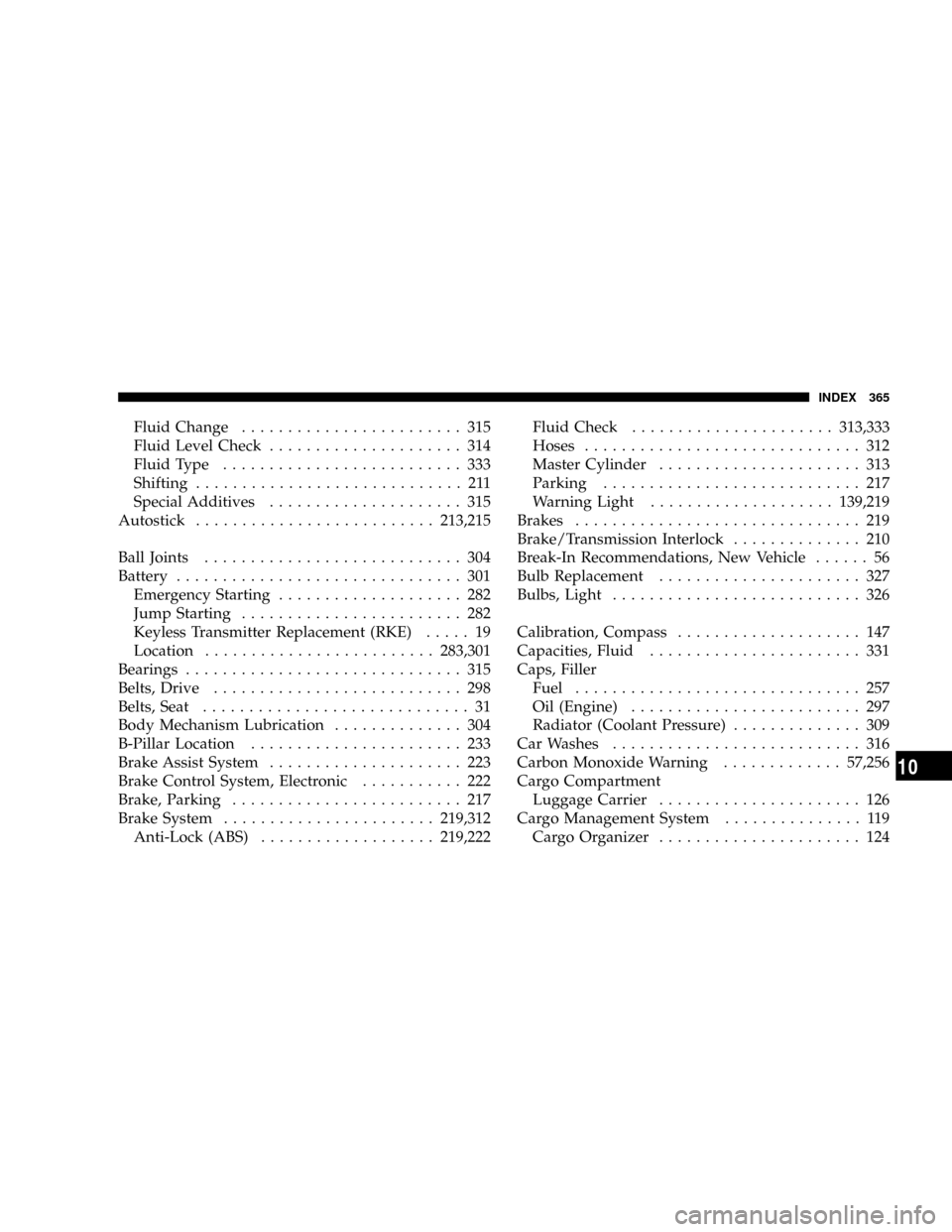
Fluid Change........................ 315
Fluid Level Check..................... 314
Fluid Type.......................... 333
Shifting............................. 211
Special Additives..................... 315
Autostick..........................213,215
Ball Joints............................ 304
Battery............................... 301
Emergency Starting.................... 282
Jump Starting........................ 282
Keyless Transmitter Replacement (RKE)..... 19
Location.........................283,301
Bearings.............................. 315
Belts, Drive........................... 298
Belts, Seat............................. 31
Body Mechanism Lubrication.............. 304
B-Pillar Location....................... 233
Brake Assist System..................... 223
Brake Control System, Electronic........... 222
Brake, Parking......................... 217
Brake System.......................219,312
Anti-Lock (ABS)...................219,222Fluid Check......................313,333
Hoses.............................. 312
Master Cylinder...................... 313
Parking............................ 217
Warning Light....................139,219
Brakes............................... 219
Brake/Transmission Interlock.............. 210
Break-In Recommendations, New Vehicle...... 56
Bulb Replacement...................... 327
Bulbs, Light........................... 326
Calibration, Compass.................... 147
Capacities, Fluid....................... 331
Caps, Filler
Fuel............................... 257
Oil (Engine)......................... 297
Radiator (Coolant Pressure).............. 309
Car Washes........................... 316
Carbon Monoxide Warning.............57,256
Cargo Compartment
Luggage Carrier...................... 126
Cargo Management System............... 119
Cargo Organizer...................... 124
INDEX 365
10
Page 367 of 380
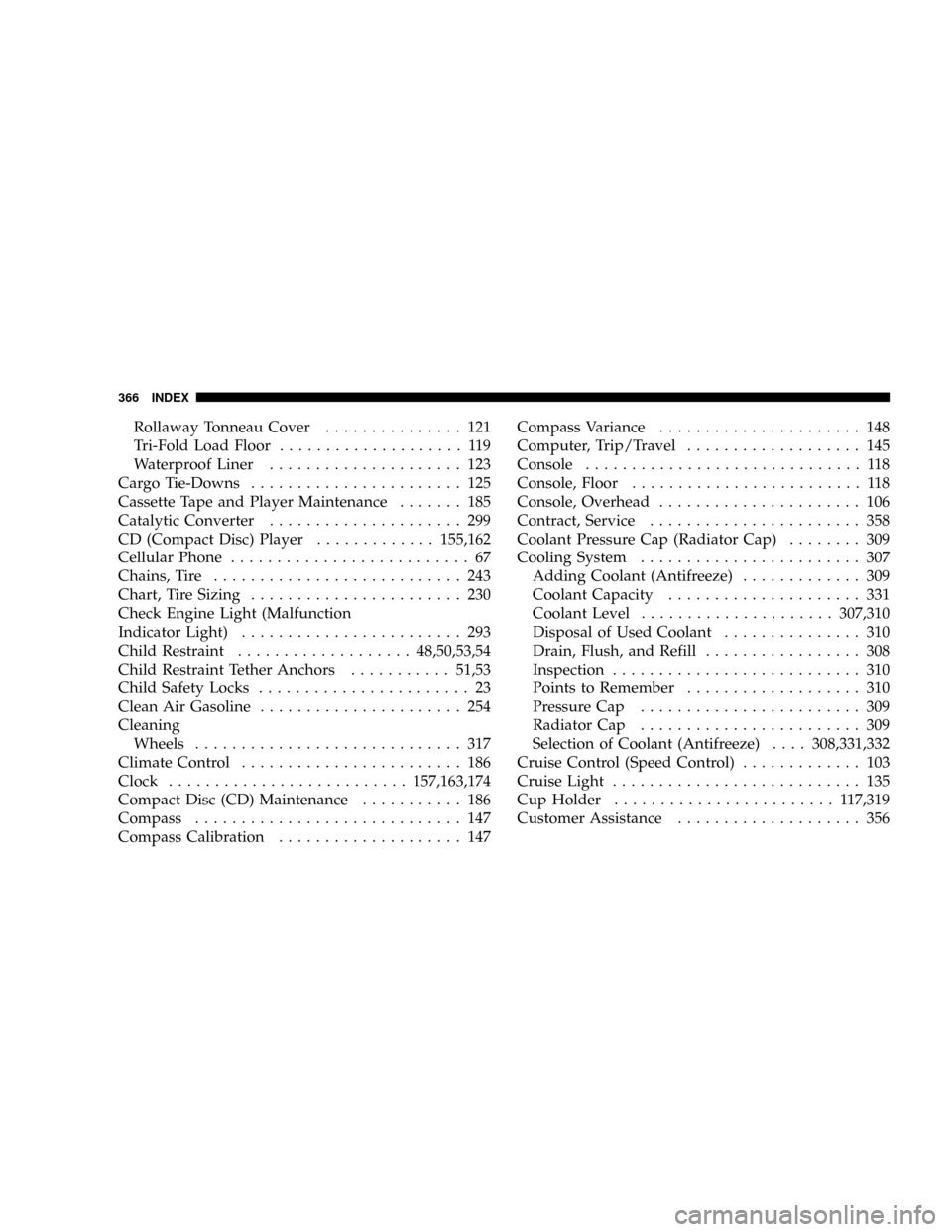
Rollaway Tonneau Cover............... 121
Tri-Fold Load Floor.................... 119
Waterproof Liner..................... 123
Cargo Tie-Downs....................... 125
Cassette Tape and Player Maintenance....... 185
Catalytic Converter..................... 299
CD (Compact Disc) Player.............155,162
Cellular Phone.......................... 67
Chains, Tire........................... 243
Chart, Tire Sizing....................... 230
Check Engine Light (Malfunction
Indicator Light)........................ 293
Child Restraint...................48,50,53,54
Child Restraint Tether Anchors...........51,53
Child Safety Locks....................... 23
Clean Air Gasoline...................... 254
Cleaning
Wheels............................. 317
Climate Control........................ 186
Clock..........................157,163,174
Compact Disc (CD) Maintenance........... 186
Compass............................. 147
Compass Calibration.................... 147Compass Variance...................... 148
Computer, Trip/Travel................... 145
Console.............................. 118
Console, Floor......................... 118
Console, Overhead...................... 106
Contract, Service....................... 358
Coolant Pressure Cap (Radiator Cap)........ 309
Cooling System........................ 307
Adding Coolant (Antifreeze)............. 309
Coolant Capacity..................... 331
Coolant Level.....................307,310
Disposal of Used Coolant............... 310
Drain, Flush, and Refill................. 308
Inspection........................... 310
Points to Remember................... 310
Pressure Cap........................ 309
Radiator Cap........................ 309
Selection of Coolant (Antifreeze)....308,331,332
Cruise Control (Speed Control)............. 103
Cruise Light........................... 135
Cup Holder........................ 117,319
Customer Assistance.................... 356
366 INDEX
Page 374 of 380
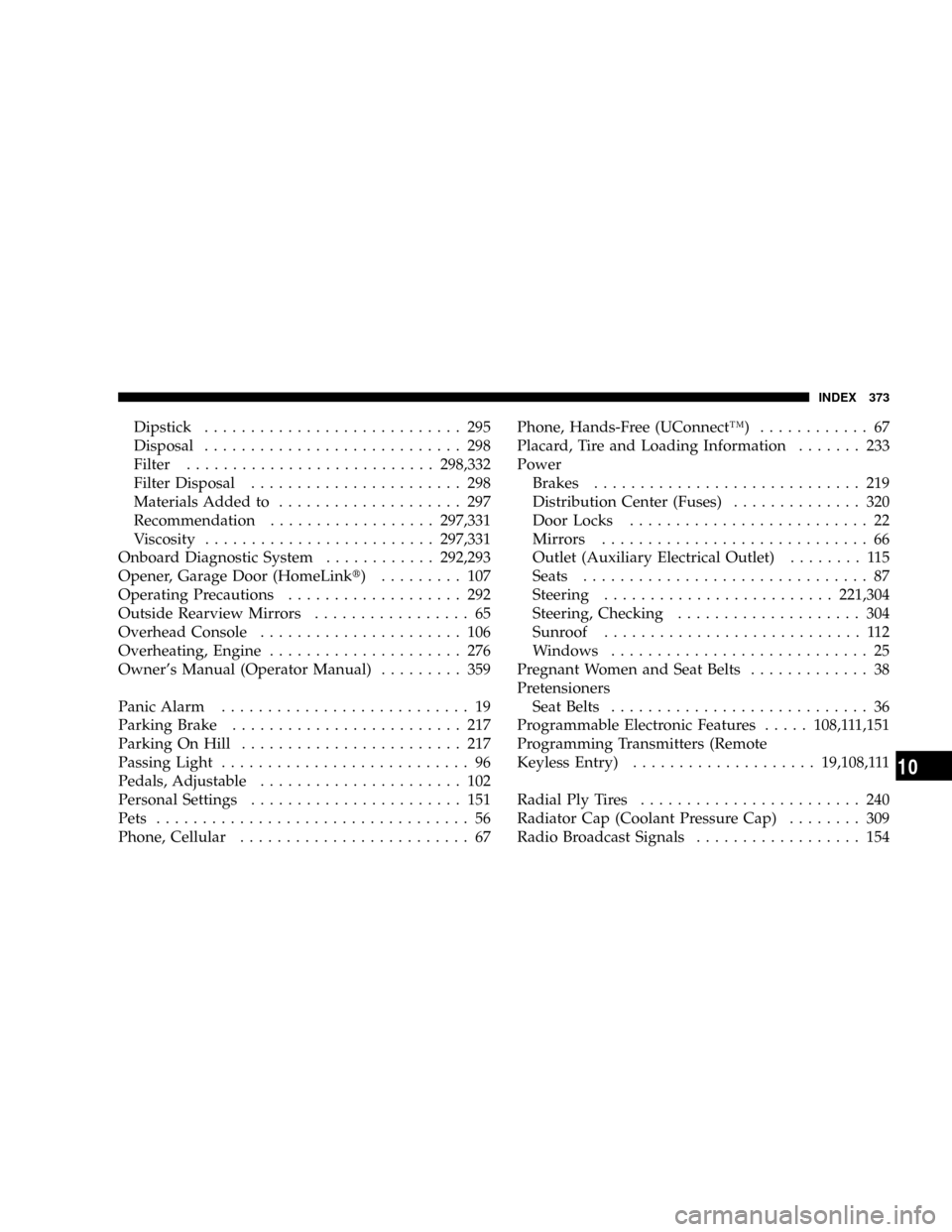
Dipstick............................ 295
Disposal............................ 298
Filter...........................298,332
Filter Disposal....................... 298
Materials Added to.................... 297
Recommendation..................297,331
Viscosity.........................297,331
Onboard Diagnostic System............292,293
Opener, Garage Door (HomeLinkt) ......... 107
Operating Precautions................... 292
Outside Rearview Mirrors................. 65
Overhead Console...................... 106
Overheating, Engine..................... 276
Owner's Manual (Operator Manual)......... 359
Panic Alarm........................... 19
Parking Brake......................... 217
Parking On Hill........................ 217
Passing Light........................... 96
Pedals, Adjustable...................... 102
Personal Settings....................... 151
Pets.................................. 56
Phone, Cellular......................... 67Phone, Hands-Free (UConnectŸ)............ 67
Placard, Tire and Loading Information....... 233
Power
Brakes............................. 219
Distribution Center (Fuses).............. 320
Door Locks.......................... 22
Mirrors............................. 66
Outlet (Auxiliary Electrical Outlet)........ 115
Seats............................... 87
Steering.........................221,304
Steering, Checking.................... 304
Sunroof............................ 112
Windows............................ 25
Pregnant Women and Seat Belts............. 38
Pretensioners
Seat Belts............................ 36
Programmable Electronic Features.....108,111,151
Programming Transmitters (Remote
Keyless Entry)....................19,108,111
Radial Ply Tires........................ 240
Radiator Cap (Coolant Pressure Cap)........ 309
Radio Broadcast Signals.................. 154
INDEX 373
10